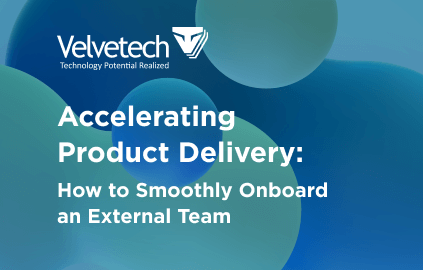The term software is quite broad and encompasses everything to do with programs used by a computer. Yet, if we dig deeper, it’s clear that there are many layers to the types of software out there.
In the current business landscape, it’s especially important to differentiate between the various tools that can solve your company’s challenges. The pandemic has forced organizations to rely heavily on the digital environment, which is why the global software market is expecting strong growth in the coming years.
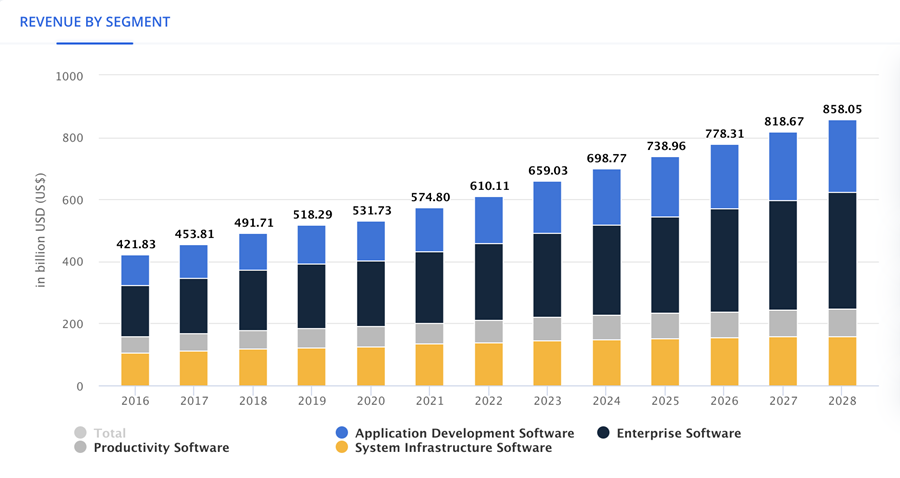
As you can see from Statista’s research, enterprise software has the largest share of the overall software market. Worldwide revenues in this category amounted to more than 270 billion U.S. dollars in 2023. It’s closely followed by application and system infrastructure software.
At this point, it’s natural to start wondering what all these software types mean. The truth is, software can be categorized in many ways. It can be sorted by common function, distribution status, development type, and dozens of other methods depending on what lens you look through. Generally, it can get confusing to navigate all the technical terms and varying categorization approaches.
So, in today’s article, we’ve decided to summarize the main types of software and show you the different categories it can fall into. Specifically, we will cover the classifications based on the following attributes:
So, make sure to bookmark this article for future reference, and let’s get started.
The Most Common Software Classification
Before we go into the above-mentioned categorizations, it’s important to note that there’s one most common classification approach. It separates IT solutions into the following categories:
- Application software
- System software
- Programming software
- Driver software
You’ll find various sources that refer to these terms, so we couldn’t bypass them. Let’s take a closer look at what each of them means.
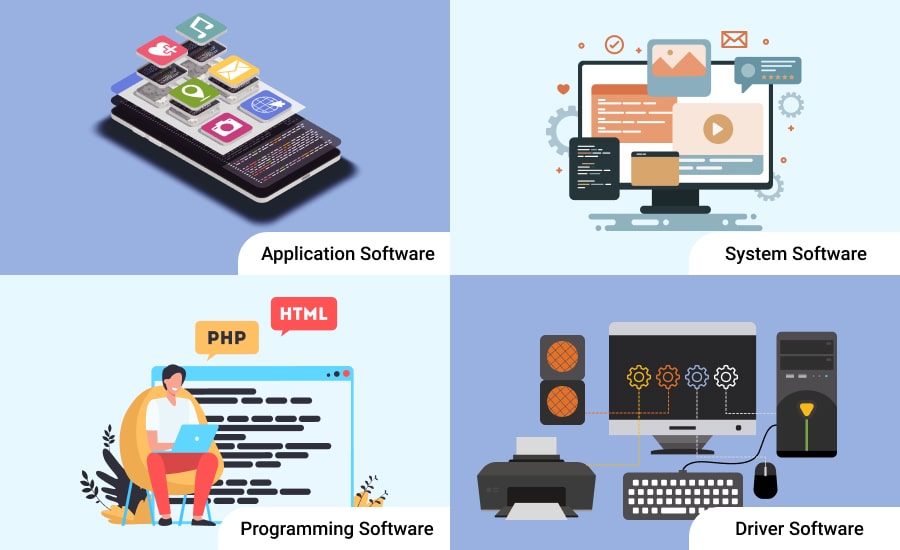
Application Software
Application software is the most common software type and the one that end-users interact with frequently. Here, we can name entertainment software, productivity apps, communication platforms, education and reference software, and graphics solutions.
Typically, application software performs a very specific function. For instance, MS Outlook was created precisely for email interactions. A CRM tool like Creatio was developed to efficiently manage customer relationships, not perform something completely unrelated. Likewise, Zoom wasn’t built for content development, instead, it focuses on video conferencing. You get the picture.
Choosing a Winning App Development Strategy
Watch our webinar to uncover effective mobile development approaches and launch your app.
System Software
System software helps manage the operations of computer hardware and application programs. It’s kind of like an intermediary that facilitates the communication between other software and the physical device. In short, it’s crucial for the functioning of the whole computer or mobile device system.
This type of software always runs in the background, and users don’t interact with it directly. Perhaps, only when it requires an update. Utility software like file management systems, antivirus programs, or disk cleanup tools are all good examples in this category.
Programming Software
Unlike application and system software, which is either designed for end-users or serves as an intermediary, this software type isn’t created for end-users at all. Instead, it’s designed for computer programmers who write code.
Specifically, programming tools are used to write, develop, test, and debug software. They can be separate solutions, or work as parts of a larger platform. .NET framework, Android SDK, and Notepad++ are popular examples of programming solutions used for building all kinds of applications.
Driver Software
Device drivers are programs that enable hardware to communicate with operating systems. In simpler terms, they operate and control external devices that can be plugged into your main one. For example, printers, speakers, and mouse all need drivers to function.
Typically, the operating system will come with built-in device drivers for most common tools like the keyboard, mouse, or printer. As you can imagine, this type of software significantly extends the functionality of your machine.
Distribution Status
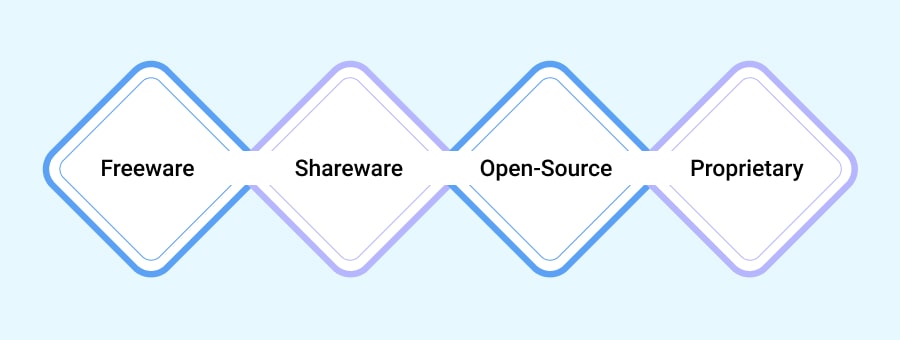
Now that you know the most common software classifications, we are going to move on to covering other examples of software types. We’ll start with distribution status, which lets us look at programs through the prism of how they are sold and the transparency of their source code.
Freeware
The term “freeware” represents software that is available without having to pay a fee. It can be downloaded from the Internet and used without any costs. However, it doesn’t allow for modification or redistribution. Skype, Adobe Reader, and Instagram are some of the most well-known examples.
Shareware
Conversely, shareware relates to solutions that you have to pay for. It’s usually free for a limited trial period, but once that passes, you will be charged a fee or have your access restricted. The great thing about this type of software application is the ability to test before buying. Netflix, Adobe Creative Suite, and Creatio CRM are excellent examples of shareware.
Open-Source Software
Moving on to open-source software. This category means that the program has an open-source code that lets programmers make changes to it. Essentially, it allows you to add features you may need because nothing is set in stone. Apache HTTP Server and LibreOffice immediately come to mind when discussing open source products.
Proprietary Software
Finally, the source code of proprietary, or closed-source, software is considered intellectual property. Hence, only the original creators can make changes and distribute it. iTunes and Google Earth are just a few examples of such applications.
Development Type
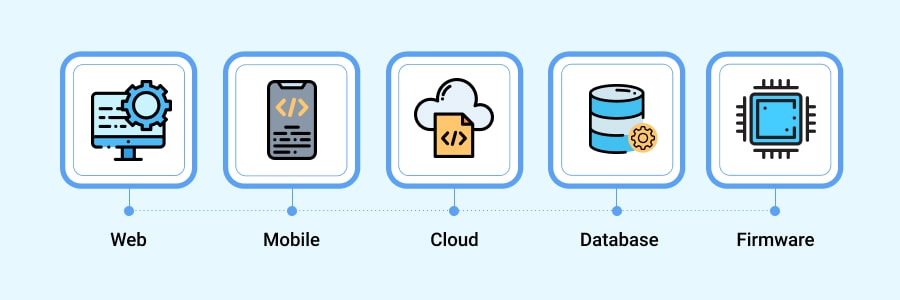
Software development relates to the process of creating, designing, and deploying various applications, platforms, and programs. Hence, it lets us categorize software from the perspective of developers and the work they perform. Read on to discover some of the different types of software development that are out there.
Web Development
Web development is all about building web applications for people to use through an internet browser across various devices. These projects typically include front-end and back-end development and range in complexity depending on client needs.
Mobile Development
Mobile application development, as the name suggests, relates to the creation of software for mobile devices. Usually, developers who work in this sphere are experts in iOS or Android operating systems. So, if you need to build a travel, social media, or another app for smartphones — this is the development process you’ll turn to.
Discover the 5 Key Mobile Development Approaches
Cloud-Based Development
Cloud computing services include the development of programs that run over the cloud. Typically, this software is used for data storage across a variety of servers. This means that it can be accessed from anywhere with an internet connection.
The cloud tends to help companies reduce IT costs, scale their business, and facilitate collaboration efforts. There are three subcategories within this development type. So, let’s take a brief look at each one of them.
Find out how Velvetech implemented a Cloud-Based Phone System For a Manufacturer
IaaS
IaaS is an abbreviation for Infrastructure as a Service. Essentially, it allows resources to be delivered to companies virtually and puts hardware management into the hands of the cloud service provider.
So, with IaaS you can control your data infrastructure without having to physically deal with on-site hardware. Instead, your data is stored on the provider servers. The most common examples of this type of software are Microsoft Azure and Amazon Web Services.
PaaS
Next is PaaS, which stands for Platform as a Service. In this case, your company is provided with a framework that your developers can use to build custom applications. So, this isn’t software per se, but a platform that your IT team can leverage to create applications.
In short, PaaS enables the online development of custom applications without having to take on data storage and management. One of the examples of this category is the Google App Engine.
SaaS
Finally, SaaS, or Software as a Service, is a program that’s hosted online by an organization and is available for purchase via subscription. These products are some of the most popular in cloud computing. They offer the most support and the simplest model of delivery.
Creatio CRM, Dropbox, and Slack are just a few examples of this type of software.
Database Development
Database software is all about data. It is used to store and manage all kinds of information. If we get a bit more technical, it fetches the needed data from a database, lets you modify whatever you need, and then stores it again.
MySQL, Microsoft SQL Server, Oracle, Apache Cassandra, and PostgreSQL are some of the most well-known database management systems.
Firmware Development
Firmware is a specific category of software that provides instructions for how the device communicates with other hardware. It’s generally stored in the flash ROM of a hardware device. Without it, most electronics wouldn’t be able to work as it helps hardware function precisely in the way that the manufacturer intended it to.
It might be a tougher category to wrap your mind around, but the good news is — there are end-to-end hardware engineering services that can help you on this journey.
Technology Focus
Next up, it’s worth discussing the different types of software from the underlying technology perspective.
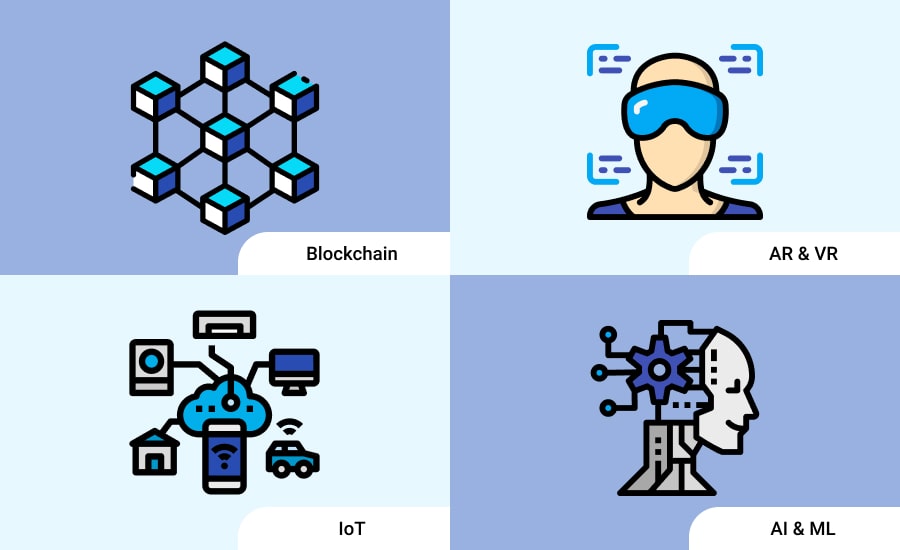
Words like blockchain, Internet of Things, artificial intelligence, machine learning as well as augmented and virtual reality have majorly garnered attention. However, not everyone knows the true potential of each of these technologies. So, let’s dive into what they are and how your company can benefit from them.
Blockchain Development
Blockchain development services are all about leveraging distributed ledgers to improve business operations. Industries like healthcare, insurance, and finance are turning to blockchain solutions to speed up processes, minimize costs, and boost security levels.
Learn about the Key Blockchain Solutions Transforming the Insurance Industry
Thanks to blockchain running on a decentralized network, there are plenty of groundbreaking use cases of the technology. Whether it’s creating smart contracts to automate agreement execution or developing your own cryptocurrency to better secure transactions — blockchain-based technologies are here to help.
IoT Development
The Internet of Things (IoT) connects physical objects and devices through a network and lets them communicate and exchange data without human involvement. Generally, IoT development is used for data collection, processing, and transferring. Thus, some of the key benefits companies observe after implementing IoT solutions are productivity improvements, error reductions, and cost savings.
Discover how Velvetech developed an IoT System for a Cold Chain Temperature Monitoring Company
However, IoT development isn’t only about creating connected devices. It can also involve the creation of a complete IoT infrastructure with devices, applications, content management systems, CRMs, and accounting solutions. Of course, time and resources are required to launch a successful IoT project, but considering the benefits, many organizations find the undertaking worth their while.
AI and ML Development
Applications that utilize artificial intelligence and machine learning help companies make the most of data. It’s no secret that the amount of data produced worldwide is growing at an exponential rate.
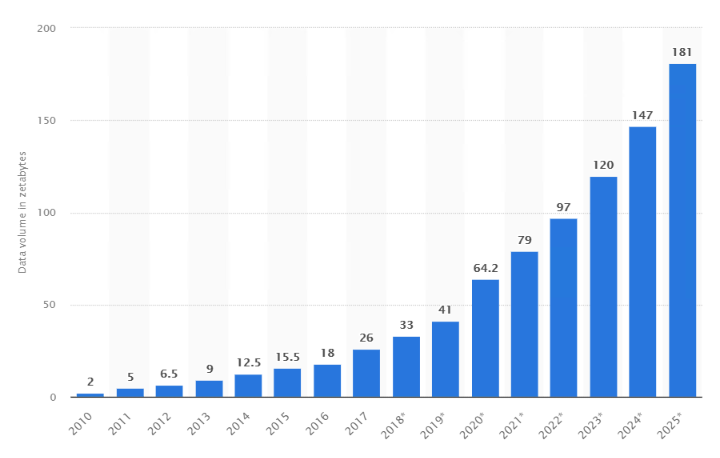
Statista forecasts that by 2025, global data volume will reach over 180 zettabytes. So, it’s easy to imagine how much data is just sitting around unused.
By leaning on data science, which lies at the core of AI and ML development, companies can extract valuable insights into customer behavior, forecast demand, and even personalize marketing initiatives.
The automation capabilities of these technologies attract busy retailers, marketers, healthcare professionals, financial institutions, and insurance providers. So, they’re definitely worth looking into if you want your company to minimize human involvement and improve existing workflows.
Plus, generative AI has entered the arena of business technology, driving the development of new types of software products. ChatGPT, Gemini, Midjourney, DALL-E, and similar software come to accelerate manual tasks, personalize customer experiences, and boost efficiency.
AR and VR Development
This category has to do with modeling real-world events for training, testing, or entertainment purposes. AR and VR enhance simulation software and let users interact with a certain situation without it actually happening in real life.
Typically, AR and VR usage is common in the fields of engineering, education, gaming, and anywhere else where imitating specific circumstances is needed.
As mentioned, simulation software differs in use. For instance, MATLAB is mainly leveraged by engineers. Unreal Engine, on the other hand, can be applied in defense or oil and gas industries — where live training can be highly dangerous and costly.
End-User Focus

In many cases, software is either made with the customers in mind or the organization itself. This is another way to look at the software application categories as it forces you to answer the “who are the end-users of my product” question. So, let’s take a look at the difference between the two options.
Consumer Apps
Consumer-focused technologies are aimed at individual users, perhaps the target audience and clients of a company. It is sold directly to end-users and frequently applied in their daily lives.
Tools like virus scanners, games, communication solutions, and content creation apps all fall under consumer software.
Enterprise Solutions
Enterprise software is built to help entire organizations, not just individual users. It includes large-scale solutions that can support a significant number of users and roles. Their primary task is to facilitate the workflow of a business.
Here are some of the most common areas enterprise software can help with:
- Call Center performance
- Document management
- Accounting and billing
- Information security
- Human Resources management
- Enterprise resource planning
- Sales and marketing automation
As you can see, enterprise solutions help businesses operate efficiently and provide back-office support. Often, the larger the organization becomes, the more it feels the need for these types of computer software.
User-Driven Approach
Watch our webinar and learn the top ways of reducing poor user satisfaction, low adoption rates, and decreased loyalty.
Function-Based Software Categorization
Since we’ve just covered the main applications of enterprise tools, now is the perfect time to discuss different types of software programs from the perspective of the functions they perform.
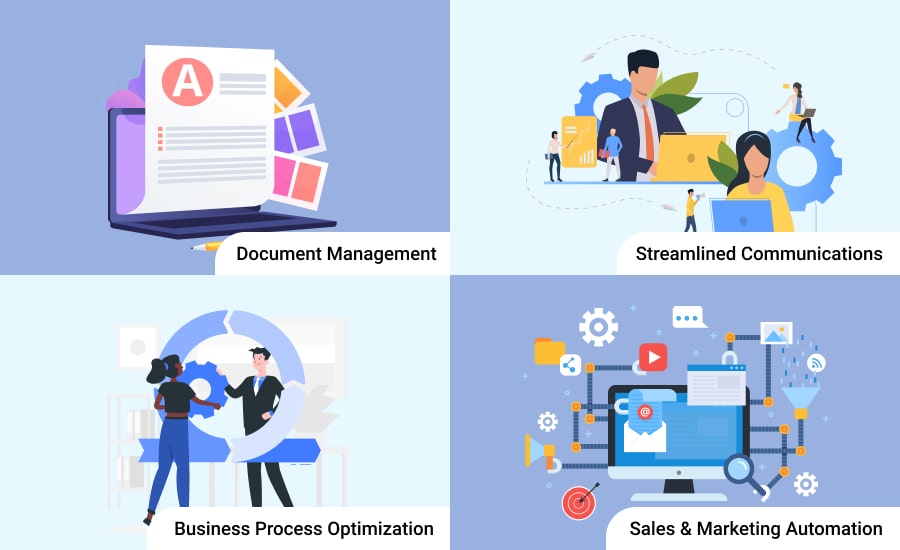
Document Management
Document management programs automate the tasks related to creating, storing, and distributing documents. They help get rid of paperwork, thus increasing efficiency and reducing operational costs.
PandaDoc and Sharepoint are great examples of this software category.
Learn about the Power of CRM and Document Management Systems
Sales and Marketing Automation
Sales and marketing are an integral part of any organization, hence automating some of their time-consuming tasks may be a top priority for business leaders.
This software type streamlines sales and marketing workflows, helps manage customer relationships, and measures the performance of campaigns. In short, it can serve as a central database of all sales and marketing activities. CRM systems are typically the best example of this category.
Explore How a CRM Can Help Streamline Your Sales Process
Business Process Optimization
Business processes can be optimized with the help of ERP and BPM software. These tools help define and monitor all company operations and automate day-to-day workflows while reducing inefficiencies, human mistakes, and miscommunication.
Discover how Velvetech Optimized Business Processes for an Executive Search Firm
Streamlined Communications
Communication software is vast, but here we want to emphasize the intelligent tools that can help your frontline employees improve customer interactions.
This type of software can include contact center suites with extensive performance insights and conversation intelligence. By integrating with CRM platforms and other decision-making solutions, it helps gain a wider control of your sales, marketing, and service team productivity.
In a nutshell, intelligent and well-tuned communication systems can ease the lives of your sales agents and help them become much more efficient.
Gaining Control of Customer Engagements
What if every customer could deal with your single most effective sales or service person?
Software Development Approach
Finally, let’s look at the different types of software applications based on the development approach. This is the last categorization we’ll discuss today, and we promise it won’t be long.

Ready-Made Software
Out-of-the-box solutions include programs that have been pre-built and aim to cater to the masses. They usually consider the general needs of many organizations as opposed to the specific requirements of a single company.
The best characteristic of this software type is that you can gain access to the solution immediately and begin leveraging it for your business needs.
Custom-Built Software
To ensure an organization gets a solution catered to its unique requirements, it is common for business leaders to turn to custom development. With this approach, no competitor will have an identical tool and you can gain something that solves your specific business challenges. Sure, it may not be the most low-cost and quick endeavor, but typically the long-term benefits are worth it.
Learn everything there is to know about Custom Software Development Costs
Some of the key advantages of this development approach are exclusive ownership, personalization, increased levels of security, and access to continuous support.
Expanding a Team
Watch our webinar to unveil the tricks of onboarding a tech partner and incorporating it into the process to foster your product delivery.
Future of Software
Our world is becoming more and more digital, and it’s no secret that those who choose to take a thoughtful approach to software development will create a tangible competitive advantage.
Technology-driven companies are already seeing their costs optimized and operations improved. Key players in all kinds of industries are doubling down on their digital efforts and have no plans of slowing down. So, what does the future of software look like?
As more software is developed, the market will be evolving at an even faster pace. New tools will solve complex problems, and businesses will be able to use IT solutions for things never before possible.
Moreover, as we see emerging technologies like voice, augmented and virtual reality gaining traction, there’s a rising need for existing solutions to integrate with them.
“Next-generation applications will need to support several interfaces such as voice, wearables, touch, AR, and VR in addition to web and mobile.”
Additionally, customers will expect best-in-class service as AI-based applications become widespread and more intelligent than ever. Technological advances will make end-users pickier and unwilling to put up with subpar service. They’ll quickly flock to competitors that can better serve their ever-changing needs.
Finally, custom software development will maintain its popularity as enterprises move away from “one-size-fits-all” solutions towards those that cater to their unique business needs and goals. The customization options are extensive with this development approach. Hence, it’s no surprise that organizations with unique business processes will lean towards bespoke tools.
Which Type of Software Is Right for You?
In the modern-day, software is all around us. Starting with the alarm going off on your phone and ending with your convenient CRM platform at work. The world has become hyper-technological, and this is likely just the beginning.
It’s important for businesses to understand the different types of software applications that are out there. By having a better grasp on the capabilities of each, corporate leaders can begin digital transformation journeys and develop solutions that help stand out from the competition.
We hope that this article helped you comprehend the different software types and the lenses through which you can look at IT solutions. However, don’t hesitate to reach out if you want a personalized consultation on how to get the right solution for your company. Velvetech’s team has been helping organizations grow their business and achieve full potential since 2004 and is always focused on delivering tangible results.









